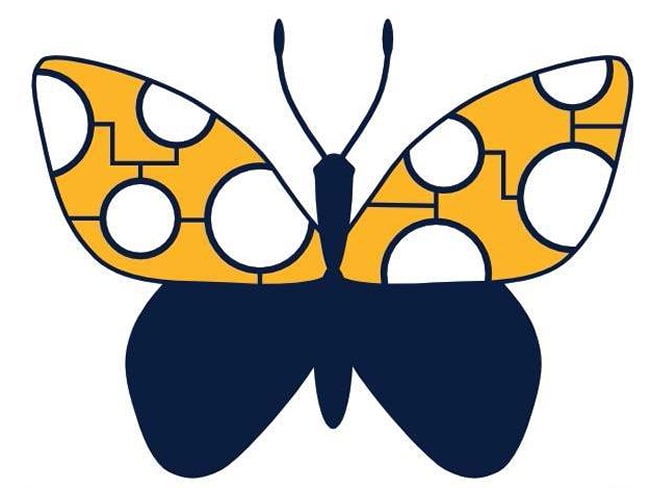


© Martin Purvis
Species Thumbnails
All families
Papilionidae
Pieridae
Nymphalidae
Lycaenidae
Hesperiidae
Full Species lists
All families
Papilionidae
Pieridae
Nymphalidae
Lycaenidae
Hesperiidae
More information
About this website
Butterflying locations
Links
Butterfly publications
YouTube videos
Tirumala hamata
Danaus petilia
Danaus affinis
Danaus plexippus
Euploea sylvester
Euploea tulliolus
Euploea darchia
Euploea corinna
Euploea eichhorni
Tellervo zoilus
Cethosia cydippe
Cethosia penthesilea
Acraea andromacha
Acraea terpsicore
Vindula arsinoe
Cupha prosope
Vagrans egista
Phalanta phalanta
Pantoporia consimilis
Pantoporia venilia
Neptis praslini
Phaedyma shepherdi
Mynes geoffroyi
Vanessa kershawi
Vanessa itea
Junonia orithya
Junonia villida
Junonia hedonia
Yoma sabina
Yoma algina
Hypolimnas alimena
Hypolimnas bolina
Hypolimnas misippus
Doleschallia bisaltide
Charaxes sempronius
Elymnias agondas
Melanitis leda
Mycalesis perseus
Mycalesis sirius
Mycalesis terminus
Tisiphone abeona
Tisiphone helena
Oreixenica kershawi
Oreixenica correae
Oreixenica lathoniella
Oreixenica orichora
Oreixenica latialis
Argynnina cyrila
Heteronympha mirifica
Heteronympha merope
Heteronympha penelope
Heteronympha paradelpha
Heteronympha banksii
Heteronympha solandri
Heteronympha cordace
Geitoneura acantha
Geitoneura klugii
Geitoneura minyas
Hypocysta angustata
Hypocysta irius
Hypocysta metirius
Hypocysta pseudirius
Hypocysta adiante
Hypocysta euphemia
Ypthima arctous
Lucia limbaria
Acrodipsas myrmecophila
Acrodipsas brisbanensis
Acrodipsas cuprea
Acrodipsas aurata
Acrodipsas arcana
Paralucia pyrodiscus
Paralucia aurifera
Paralucia spinifera
Pseudodipsas eone
Pseudodipsas cephenes
Hypochrysops narcissus
Hypochrysops miskini
Hypochrysops digglesii
Hypochrysops byzos
Hypochrysops apelles
Hypochrysops ignitus
Hypochrysops piceatus
Hypochrysops epicurus
Hypochrysops delicia
Hypochrysops halyaetus
Philiris innotata
Philiris nitens
Arhopala eupolis
Arhopala madytus
Arhopala micale
Arhopala wildei
Ogyris olane
Ogyris barnardi
Ogyris amaryllis
Ogyris abrota
Ogyris ianthis
Ogyris aenone
Ogyris genoveva
Ogyris zosine
Ogyris arcana
Ogyris idmo
Ogyris petrina
Jalmenus daemeli
Jalmenus eichhorni
Jalmenus lithochroa
Jalmenus ictinus
Jalmenus pseudictinus
Jalmenus evagoras
Jalmenus eubulus
Jalmenus icilius
Jalmenus inous
Pseudalmenus chlorinda
Hypolycaena danis
Hypolycaena phorbas
Deudorix diovis
Deudorix democles
Deudorix smilis
Rapala varuna
Bindahara phocides
Anthene seltuttus
Anthene lycaenoides
Eirmocides callainus
Eirmocides margarita
Eirmocides absimilis
Eirmocides consimilis
Cyprotides cyprotus
Cyprotides pallescens
Erina hyacinthina
Erina geminus
Erina erina
Erina acasta
Candalides xanthospilos
Candalides heathi
Candalides urumelia
Petrelaea tombugensis
Nacaduba berenice
Nacaduba kurava
Nacaduba cyanea
Nacaduba biocellata
Danis danis
Psychonotis caelius
Prosotas nora
Prosotas felderi
Prosotas dubiosa
Catopyrops florinda
Ionolyce helicon
Jameela palmyra
Erysichton lineatus
Neolucia mathewi
Neolucia hobartensis
Neolucia agricola
Sahulana scintillata
Theclinesthes serpentatus
Theclinesthes sulpitius
Theclinesthes onycha
Theclinesthes miskini
Theclinesthes albocinctus
Theclinesthes hesperia
Jamides phaseli
Jamides cyta
Jamides aleuas
Catochrysops panormus
Lampides boeticus
Leptotes plinius
Zizeeria karsandra
Zizina otis
Famegana alsulus
Zizula hylax
Everes lacturnus
Megisba strongyle
Udara cardia
Euchrysops cnejus
Freyeria putli
Badamia exclamationis
Hasora discolora
Hasora hurama
Hasora chromus
Hasora khoda
Allora major
Euschemon rafflesia
Netrocoryne repanda
Tagiades japetus
Trapezites phigalia
Trapezites phigalioides
Trapezites iacchoides
Trapezites maheta
Trapezites praxedes
Trapezites luteus
Trapezites sciron
Trapezites atkinsi
Trapezites argenteoornatus
Trapezites waterhousei
Trapezites macqueeni
Trapezites petalia
Trapezites iacchus
Trapezites heteromacula
Trapezites eliena
Trapezites symmomus
Anisynta cynone
Anisynta tillyardi
Anisynta monticolae
Atkinsia dominula
Pasma tasmanica
Dispar compacta
Toxidia senta
Toxidia xiphiphora
Toxidia crocea
Toxidia xanthomera
Toxidia thyrrhus
Toxidia parvula
Toxidia andersoni
Toxidia rietmanni
Toxidia doubledayi
Toxidia inornata
Timoconia peron
Timoconia melania
Timoconia flammeata
Timoconia tymbophora
Hesperilla munionga
Hesperilla ornata
Hesperilla picta
Hesperilla crypsargyra
Hesperilla mastersi
Hesperilla idothea
Hesperilla donnysa
Hesperilla malindeva
Hesperilla sarnia
Hesperilla crypsigramma
Hesperilla sexguttata
Hesperilla dirphia
Hesperilla trimaculata
Antipodia chaostola
Antipodia atralba
Antipodia dactyliota
Croitana croites
Herimosa albovenata
Mesodina aeluropis
Mesodina halyzia
Mesodina gracillima
Mesodina cyanophracta
Notocrypta waigensis
Parnara bada
Parnara amalia
Borbo impar
Pelopidas lyelli
Pelopidas agna
Taractrocera papyria
Taractrocera ina
Taractrocera dolon
Taractrocera ilia
Ocybadistes flavovittatus
Ocybadistes walkeri
Ocybadistes knightorum
Ocybadistes ardea
Suniana sunias
Suniana lascivia
Arrhenes marnas
Arrhenes dschilus
Telicota eurotas
Telicota eurychlora
Telicota colon
Telicota ancilla
Telicota ohara
Telicota anisodesma
Telicota augias
Telicota paceka
Cephrenes augiades
Cephrenes trichopepla
Sabera caesina
Sabera dobboe
Sabera fuliginosa

Thursday 24th October saw the launch of Butterflies Australia, a new citizen science project aimed at getting Australians involved in building a database of butterfly records, so as to make it possible for scientists to get a much better understanding our our butterfly populations.
To my mind this is long overdue, as despite the fact that most people seem to quite like butterflies our knowledge of them is woefully inadequate. Unless we greatly increase our understanding of their distributions and biology we have virtually no hope of making any meaningful conservation efforts, and now we can all help by contributing records of our butterfly sightings.
I registered as a user on the Butterflies Australia website, and having done so I can use the Sightings Search option to browse through the records that have already been submitted, with options to filter them by family, genus and species. I can also enter records via the My Surveys option; I’ll be doing this during the current butterfly season and in the winter months I hope to get time to go back through my own records and enter details from past expeditions.
I suspect the accompanying phone App will be used to submit more sightings, as it’s very simple to use it whilst out in the field observing the butterflies – provided you’re in mobile coverage of course. I first tried this last weekend when I was at Shoal Bay looking for Copper Ant-blues (Acrodipsas cuprea). I had intentionally not attempted to try using the App for this beforehand, so I could see how easy it might be to submit a sighting in the field with no previous experience. I found it very easy, except that the Submit button was not as obvious as it might be, so for a while my Survey was complete on my phone but had not been submitted to the database.
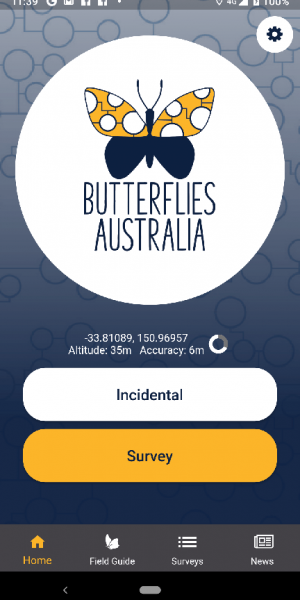
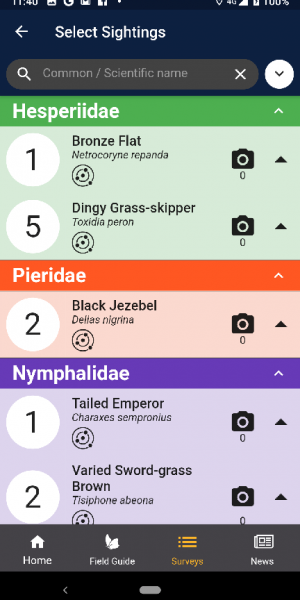
The App also has a Field Guide; whilst it’s still a work in progress I think it will become an invaluable resource. It allows you to easily browse through all the Australian butterfly species; for most of them it provides photos, descriptions, notes on behaviour and habitat, and distribution maps.
I really like the distribution maps; if you tap the map it displays a scaleable version with a blue dot representing your current position. My only quibble is that the species’ distribution is shown with a uniform green colour; I’d have liked to have seen different colours for the various subspecies (where applicable).
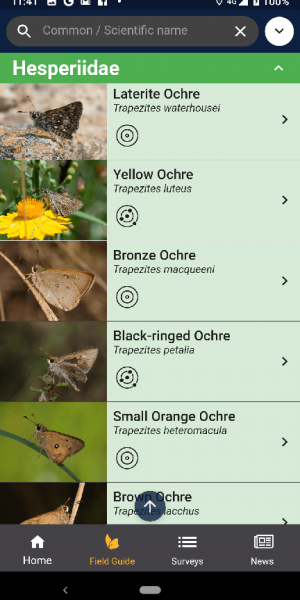
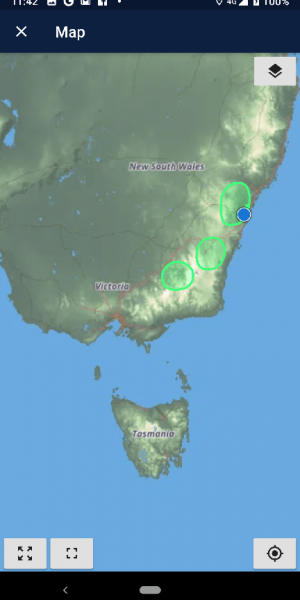
I must admit, I have spent quite a bit of time browsing through the photos in the field guide. It contains several shots of many of the species, though it’s not always very obvious that more than one shot is available. Where you see some white dots across a photo it means there are others to see, which you can view by swiping. Just like with Tinder, when you swipe you may just see something you fall in love with…
A number of people have contributed photos for the Field Guide; I have found Geoff Walker‘s Toxidia senta, Todd Burrows‘ Delias argenthona and Christine Darwood’s stunning female Acrodipsas myrmecophila (upperside!) to be particularly lustworthy. The guide has quite a number of my own photos as well, which I’m rather happy about.
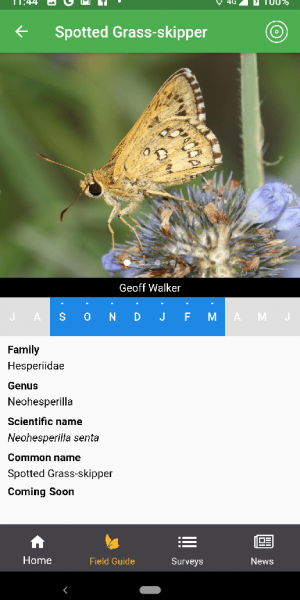
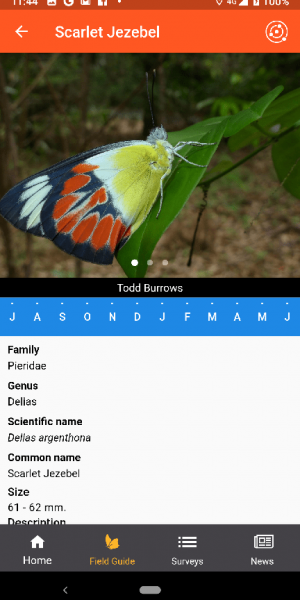
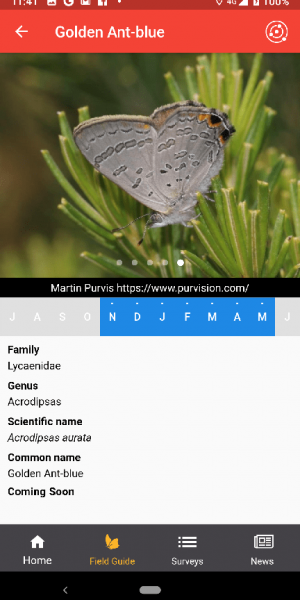
It doesn’t cost anything to register on Butterflies Australia, and the App is free too (available in the Google Play store for Android devices and the Apple store for iPhones and iPads). I urge anyone with any interest in our wildlife – not just butterflies – to get involved and log their butterfly sightings. The more records we all contribute the more valuable the database will become, and all the data will be included in the Atlas of Living Australia too.